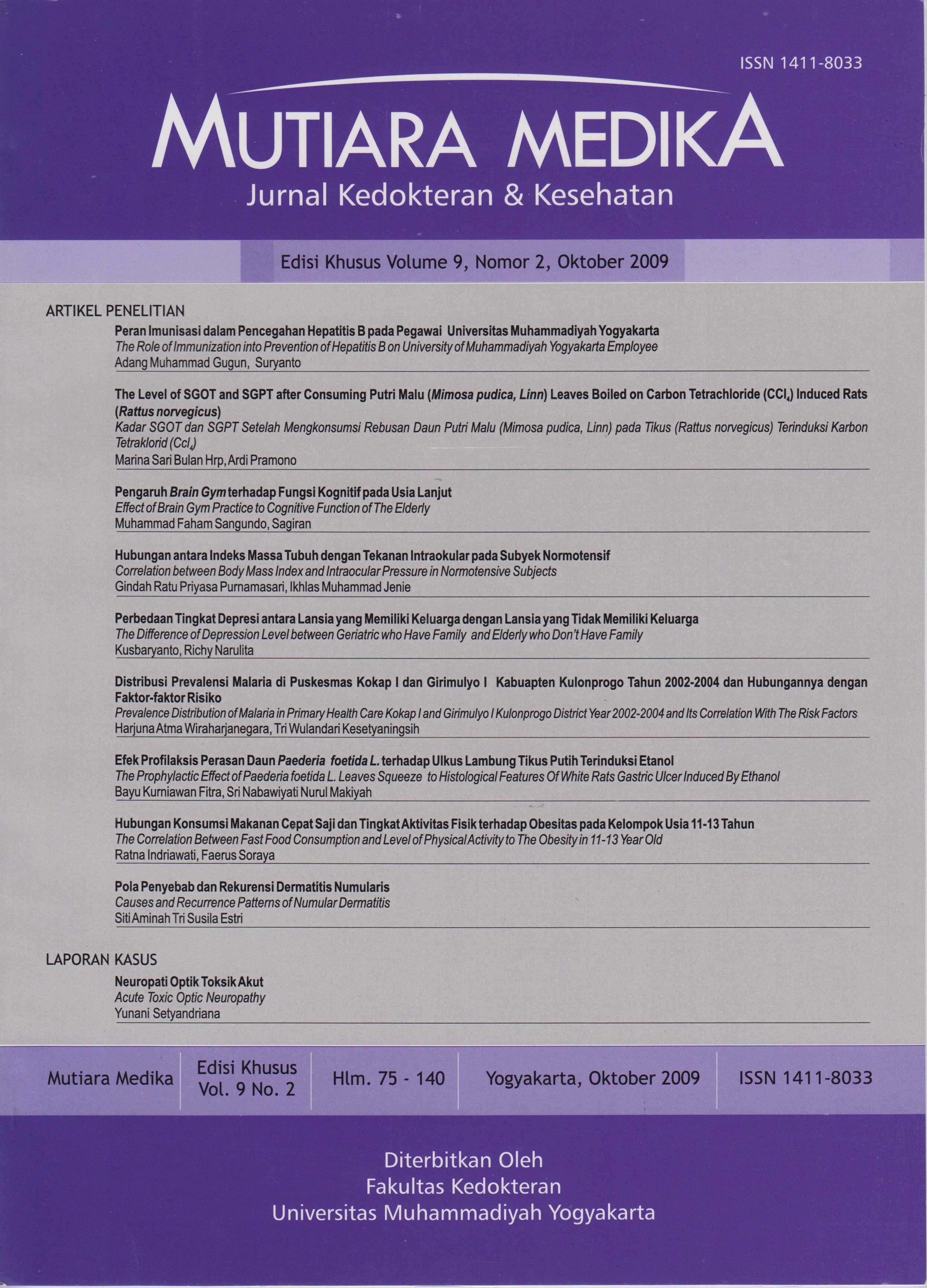Hubungan Konsumsi Makanan Cepat Saji dan Tingkat Aktivitas Fisik terhadap Obesitas pada Kelompok Usia 11-13 Tahun
DOI:
https://doi.org/10.18196/mmjkk.v9i2%20(s).1615Keywords:
aktivitas fisik, makanan cepat saji, obesitas, remaja, adolescent, fast food, obesity, physical activityAbstract
Obesity is a chronic condition characterized by an excess of body fat. Obesity in adolescence also cause a problem for social life and emotional. Food habit in adolescent is significantly influenced by their life style, including the consumption of fast food. This research was aimed to know whether consumption of fast food and physical activity is a risk factor of obesity in adolescent. This research was observed with cross-sectional design. Subject were students of SLTP, aged 11-13 year old samples for obesity were obtained by random sampling. The data of obesity prevalence were calculate based on the number of obesity students. The correlation of fast food consumption and physical activity with obesity was analyzed with regression and correlation analysis. There was no significant correlation between the amount of fast food and fast food consumption frequency and obesity (p> 0.05), while the level of physical activity has a significant correlation with obesity (p<0.05). The contribution of fast-food consumption does not increase the risk of obesity and the higher level of physical activity, the lower the risk of obesity.
Obesitas merupakan kondisi kronis dengan karakteristik kelebihan lemak tubuh. Obesitas pada remaja juga menyebabkan masalah bagi kehidupan sosial dan emosi yang cukup berarti. Kebiasaan makan pada remaja dipengaruhi secara signifikan oleh perubahan gaya hidup mereka, temasuk mengkonsumsi makanan cepat saji. Penelitian ini bertujuan mengetahui apakah konsumsi fast food dan tingkat aktivitas fisik merupakan faktor risiko terjadinya obesitas pada remaja. Penelitian ini bersifat observasional dengan menggunakan rancangan cross-sectional. Populasi dan sampel adalah remaja SLTP dengan usia 11-13 tahun, dengan pengambilan sampel untuk penjaringan obesitas secara random sampling. Analisis untuk mengetahui hubungan konsumsifast food dan tingkat aktivitas fisik terhadap obesitas dilakukan dengan menggunakan regresi dan korelasi. Tidak ada hubungan yang bermakna antara banyaknyajenisfast food dan frekuensi konsumsi fast food terhadap obesitas (p>0,05) sedangkan tingkat aktivitas fisik memiliki hubungan bermakna dengan obesitas (p<0,05). Kontribusi konsumsi fast food tidak meningkatkan resiko terjadinya obesitas. Semakin tinggi tingkat aktivitas fisik, semakin rendah resiko terjadinya obesitas.
References
Azwar. A, (2004). Tubuh Sehat Ideal Dari Segi Kesehatan. Jakarta : Disampaikan pada Seminar Kesehatan Obesitas.
Wang, Z., Patterson, C. M. & Hills, A. P. (2002) Association between Overweight or obesity and Household Income and Parental Body Mass Index in Australian Youth: Analisis of the Australian National Nutrition Survey, 1995. American Journal Clinical Nutrition, 11 (3): 200-205
Kong TC, (2003). Promoting Physical Activity at A National Level The Singapore Experience, Combating The Obesity Epidemic : A Shared Responsibility, Second Asia Oceania Conference on obesity, Malaysia September 7-9,
Khomsan, A. 2003. Pangan dan Gizi Untuk Kesehatan. Raja Grafindo Persada, Jakarta.
Goran, M.I. (1998). Measurement Issues Related to Studies of Chilhood Obesity: Assessment of Body Composition, Body Fat Distribution, Physical Activity, and Food Intake. Pediatric, 101 (suppl), 505-518.
Padmiarti, Ida.A.E, Hadi. H. (2002). Konsumsi fast food sebagai factor resiko obesitas Pada Remaja. Cermin Dunia Kedokteran No. 30.
Huriyati, E. 2003. Aktifitas Fisik Remaja di Kota Yogyakarta dan Kabupaten Bantul serta peran Aktifitas Fisik Menyumbang Terhadap Kejadian Obesitas. Tesis, Universitas Gajah Mada. Yogyakarta.
Downloads
Published
Issue
Section
License
Copyright
Authors retain copyright and grant Mutiara Medika: Jurnal Kedokteran dan Kesehatan (MMJKK) the right of first publication with the work simultaneously licensed under an Attribution 4.0 International (CC BY 4.0) that allows others to remix, adapt and build upon the work with an acknowledgment of the work's authorship and of the initial publication in Mutiara Medika: Jurnal Kedokteran dan Kesehatan (MMJKK).
Authors are permitted to copy and redistribute the journal's published version of the work (e.g., post it to an institutional repository or publish it in a book), with an acknowledgment of its initial publication in Mutiara Medika: Jurnal Kedokteran dan Kesehatan (MMJKK).
License
Articles published in the Mutiara Medika: Jurnal Kedokteran dan Kesehatan (MMJKK) are licensed under an Attribution 4.0 International (CC BY 4.0) license. You are free to:
- Share — copy and redistribute the material in any medium or format.
- Adapt — remix, transform, and build upon the material for any purpose, even commercially.
This license is acceptable for Free Cultural Works. The licensor cannot revoke these freedoms as long as you follow the license terms. Under the following terms:
Attribution — You must give appropriate credit, provide a link to the license, and indicate if changes were made. You may do so in any reasonable manner, but not in any way that suggests the licensor endorses you or your use.
- No additional restrictions — You may not apply legal terms or technological measures that legally restrict others from doing anything the license permits.






